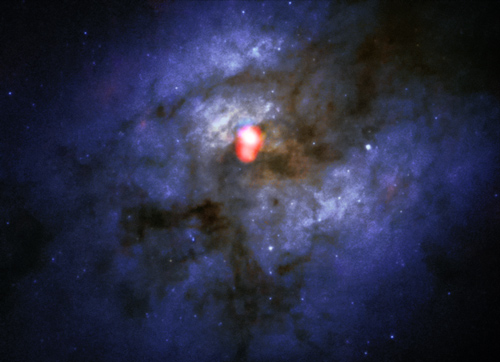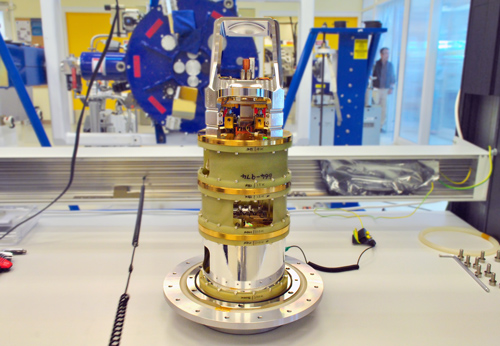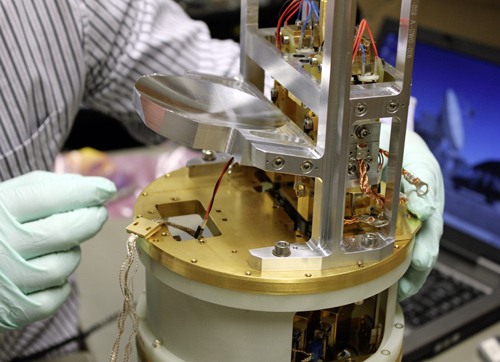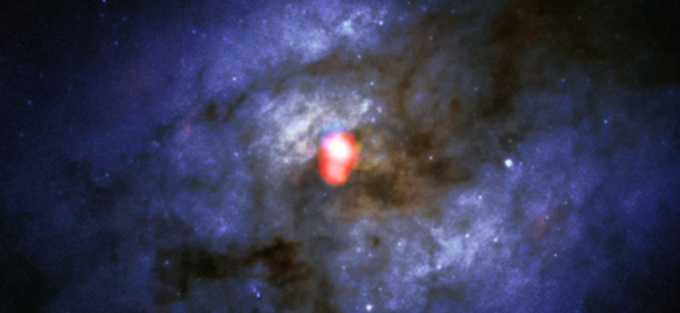ALMA Improves Ability to Search for Water in the Universe
21 December, 2016 / Read time: 7 minutes
ALMA Kids PublicationWith the First Light for Band 5, the Atacama Large Millimeter/submillimeter Array (ALMA) has begun observing in a new range of the electromagnetic spectrum. This has been made possible thanks to new receivers installed at the telescope’s antennas, which can detect radio waves with wavelengths from 1.4 to 1.8 millimeters — a range previously untapped by ALMA. This upgrade allows astronomers to detect faint signals of water in the nearby Universe.
ALMA observes radio waves from the Universe, at the low-energy end of the electromagnetic spectrum. With the newly installed Band 5 receivers, ALMA has now opened its eyes to a whole new section of this radio spectrum, creating exciting new observational possibilities.
The European ALMA Program Scientist, Leonardo Testi, explains the significance: “The new receivers will make it much easier to detect water, a prerequisite for life as we know it, in our Solar System and in more distant regions of our galaxy and beyond. They will also allow ALMA to search for ionized carbon in the primordial Universe.”

The compound view shows a new ALMA Band 5 view of the colliding galaxy system Arp 220 (in red) on top of an image from the NASA/ESA Hubble Space Telescope (blue/green). With the newly installed Band 5 receivers, ALMA has now opened its eyes to a whole new section of this radio spectrum, creating exciting new observational possibilities and improving the telescope’s ability to search for water in the Universe. This image is one of the first taken using Band 5 and was intended to verify the scientific capability of the new receivers. Credit: ALMA(ESO/NAOJ/NRAO)/NASA/ESA and The Hubble Heritage Team (STScI/AURA) | Download image
It is ALMA’s unique location, 5000 meters up on the barren Chajnantor plateau in Chile, that makes such an observation possible in the first place. As water is also present in Earth’s atmosphere, observatories in less elevated and less arid environments have much more difficulty identifying the origin of the emission coming from space. ALMA’s great sensitivity and high angular resolution mean that even faint signals of water in the local Universe can now be imaged at this wavelength1.
The Band 5 receiver, which was developed by the Group for Advanced Receiver Development (GARD) at Onsala Space Observatory, Chalmers University of Technology, Sweden, has already been tested at the APEX. These observations were also vital to help select suitable targets for the first receiver tests with ALMA.

Band 5 receiver integrated with receivers for all the other current ALMA Bands (3 to 10). Credit: N. Tabilo - ALMA (ESO/NAOJ/NRAO). | Download image
The first production receivers were built and delivered to ALMA in the first half of 2015 by a consortium consisting of the Netherlands Research School for Astronomy (NOVA) and GARD in partnership with the National Radio Astronomy Observatory (NRAO), which contributed the local oscillator to the project. "The major challenge has been to prepare the new receivers for the scientific tests on sky, without affecting the observations that are in progress," says team member Gianni Marconi. "This was successful thanks to the great efforts of all the people involved at JAO, both engineers and astronomers." The integration process to equip all antennas with the new receivers is still in progress. It will be completed next year in time to offer this new and important observing window to the scientific community for the next observing period.
To test the newly installed receivers observations were made of several objects including the colliding galaxies Arp 220, a massive region of star formation close to the center of the Milky Way, and also a dusty red supergiant star approaching the supernova explosion that will end its life2.

This picture shows one of the Band 5 receiver cartridges built for the Atacama Large Millimeter/submillimeter Array (ALMA). Extremely weak signals from space are collected by the ALMA antennas and focussed onto the receivers, which transform the faint radiation into an electrical signal. The Band 5 receivers detect electromagnetic radiation with wavelengths between about 1.4 and 1.8 millimeters (211 and 163 gigahertz). The receivers were originally designed, developed, and prototyped by Onsala Space Observatory’s Advanced Receiver Development group, based at Chalmers University of Technology in Gothenburg, Sweden, in collaboration with the Rutherford Appleton Laboratory, UK, and the European southern Observatory (ESO), under the European Commission (EC) supported Framework Programme FP6 (ALMA Enhancement). Band 5 of ALMA achieved first fringes in July 2015 and first science observations were made in late 2016. Credit: Onsala Space Observatory/Alexey Pavolotsky | Download image
To process the data and check its quality, astronomers, along with technical specialists from ESO and the European ALMA Regional Center (ARC) network, gathered at the Onsala Space Observatory in Sweden, for a "Band 5 Busy Week" hosted by the Nordic ARC node3. The final results have just been made freely available to the astronomical community worldwide.

This picture shows one of the Band 5 receiver cartridges built for the Atacama Large Millimeter/submillimeter Array (ALMA). Extremely weak signals from space are collected by the ALMA antennas and focussed onto the receivers, which transform the faint radiation into an electrical signal. The Band 5 receivers detect electromagnetic radiation with wavelengths between about 1.4 and 1.8 millimeters (211 and 163 gigahertz). The receivers were originally designed, developed, and prototyped by Onsala Space Observatory’s Advanced Receiver Development group, based at Chalmers University of Technology in Gothenburg, Sweden, in collaboration with the Rutherford Appleton Laboratory, UK, and ESO, under the European Commission (EC) supported Framework Programme FP6 (ALMA Enhancement). Band 5 of ALMA achieved first fringes in July 2015 and the first science observations were made in late 2016. Credit: Onsala Space Observatory/B. Billade | Download image
Team member Robert Laing at ESO is optimistic about the prospects for ALMA Band 5 observations: “It's very exciting to see these first results from ALMA Band 5 using a limited set of antennas. In the future, the high sensitivity and angular resolution of the full ALMA array will allow us to make detailed studies of water in a wide range of objects including forming and evolved stars, the interstellar medium and regions close to supermassive black holes.”
Additional information
The Atacama Large Millimeter/submillimeter Array (ALMA), an international astronomy facility, is a partnership of the European Organisation for Astronomical Research in the Southern Hemisphere (ESO), the U.S. National Science Foundation (NSF) and the National Institutes of Natural Sciences (NINS) of Japan in cooperation with the Republic of Chile. ALMA is funded by ESO on behalf of its Member States, by NSF in cooperation with the National Research Council of Canada (NRC) and the Ministry of Science and Technology (MOST) in Taiwan and by NINS in cooperation with the Academia Sinica (AS) in Taiwan and the Korea Astronomy and Space Science Institute (KASI).
ALMA construction and operations are led by ESO on behalf of its Member States; by the National Radio Astronomy Observatory (NRAO), managed by Associated Universities, Inc. (AUI), on behalf of North America; and by the National Astronomical Observatory of Japan (NAOJ) on behalf of East Asia. The Joint ALMA Observatory (JAO) provides the unified leadership and management of the construction, commissioning and operation of ALMA.
- A key spectral signature of water lies in this expanded range — at a wavelength of 1.64 millimeters. ↩
- The observations were performed and made possible by the ALMA Extension of Capabilities team in Chile. ↩
- The ESO Band 5 Science Verification team includes: Elizabeth Humphreys, Tony Mroczkowski, Robert Laing, Katharina Immer, Hau-Yu (Baobab) Liu, Andy Biggs, Gianni Marconi and Leonardo Testi. The team working on processing the data included: Tobia Carozzi, Simon Casey, Sabine König, Ana Lopez-Sepulcre, Matthias Maercker, Iván Martí-Vidal, Lydia Moser, Sebastien Muller, Anita Richards, Daniel Tafoya and Wouter Vlemmings. ↩
Contacts
-
Leonardo Testi
European ALMA Programme Scientist, ESO
Garching bei München, Germany
Phone: +49 89 3200 6541
Email: [email protected]
-
Robert Laing
-
Nicolás Lira
Education and Public Outreach Coordinator
Joint ALMA Observatory, Santiago - Chile
Phone: +56 2 2467 6519
Cel: +56 9 9445 7726
Email: [email protected]
-
Richard Hook
Public Information Officer, ESO
Garching bei München, Germany
Phone: +49 89 3200 6655
Cel: +49 151 1537 3591
Email: [email protected]
-
Masaaki Hiramatsu
Education and Public Outreach Officer, NAOJ Chile
Observatory, Tokyo - Japan
Phone: +81 422 34 3630
Email: [email protected]
-
Charles E. Blue
Public Information Officer
National Radio Astronomy Observatory Charlottesville, Virginia - USA
Phone: +1 434 296 0314
Cel: +1 202 236 6324
Email: [email protected]

